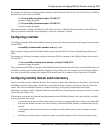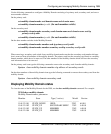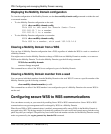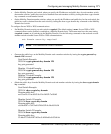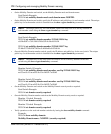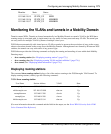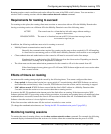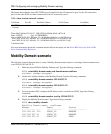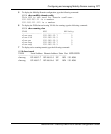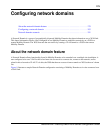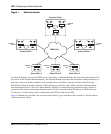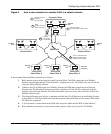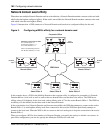
Configuring and managing Mobility Domain roaming 175
Nortel WLAN—Security Switch 2300 Series Configuration Guide
Roaming requires certain conditions and can be affected by some of the WSS switch’s timers. You can monitor a
wireless client’s roaming sessions with the show sessions network verbose command.
Requirements for roaming to succeed
For roaming to take place, the roaming client must associate or reassociate with an AP in the Mobility Domain after
leaving an existing session on a different AP in the Mobility Domain in one of the following states:
In addition, the following conditions must exist for roaming to succeed:
• Mobility Domain communications must be stable.
Generally, the communications required for roaming are the same as those required for VLAN tunneling.
A client can also roam among ports on a WSS when a Mobility Domain is inaccessible or not configured.
• Client authentication and authorization on the roamed-to AP must be successful on the first attempt.
If authentication or authorization fails, WSS Software clears the client session. Depending on when the
failure occurs, roaming can be disqualified or delayed.
• The client must use the same authorization parameters for the roamed-to AP as for the roamed-from AP.
If the client changes its encryption type or VLAN name, WSS Software might record a new session rather
than a roamed session.
Effects of timers on roaming
An unsuccessful roaming attempt might be caused by the following timers. You cannot configure either timer.
• Grace period. A disassociated session has a grace period of 5 seconds during which WSS Software can retrieve
and forward the session history. After 5 seconds, WSS Software clears the session, and its accounting is stopped.
• MAC address search. If WSS Software cannot find the client’s MAC address in a Mobility Domain within
5 seconds, it treats the session as a new session rather than a roaming session.
In contrast, the 802.1X reauthentication timeout period has little effect on roaming. If the timeout expires, WSS
Software performs 802.1X processing on the existing association. Accounting and roaming history are unaffected when
reauthentication is successful, because the client is still associated with the same AP. If reauthentication fails, WSS
Software clears the session so it is not eligible for roaming.
If the client associates with the same AP, the session is recorded as a new session.
(To change the reauthentication timeout, see “Setting the 802.1X reauthentication period” (page 582).)
Monitoring roaming sessions
To monitor the state of roaming clients, use the show sessions network verbose command. For example, the following
command displays information about the sessions of a wireless client who roamed between the ports on a WSS.
ACTIVE The normal state for a client that has left radio range without sending a
request to disassociate.
DEASSOCIATED The state of a client that has sent an 802.11 disassociate message, but has
not roamed or aged out yet.



